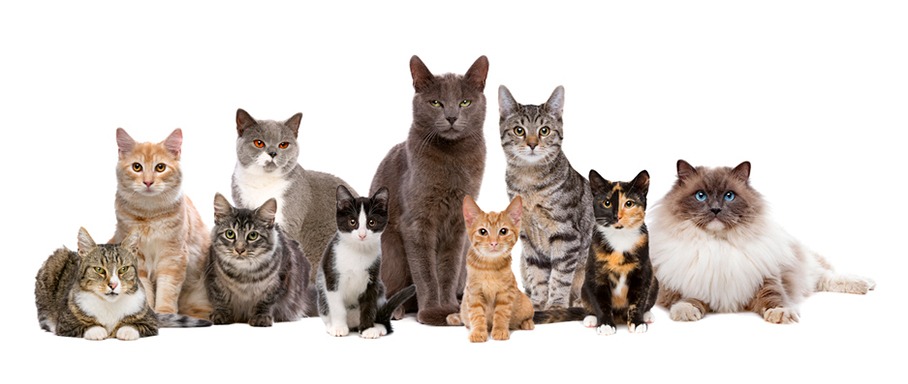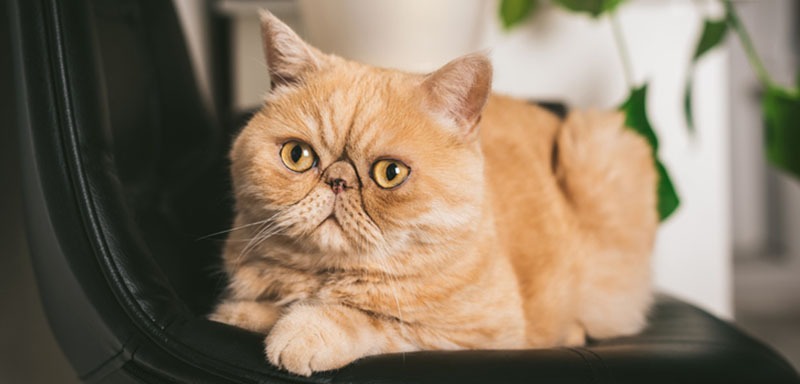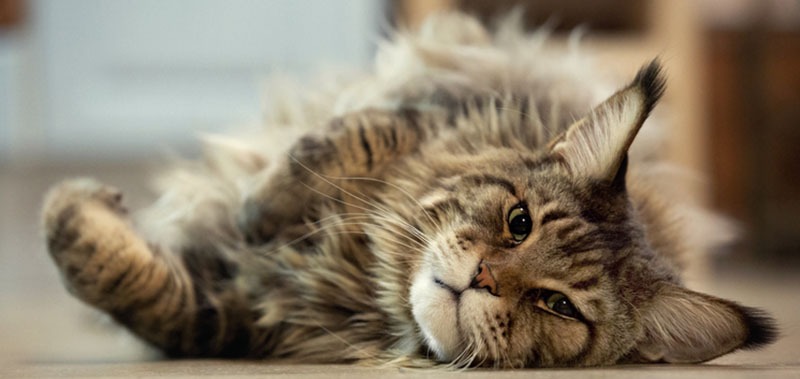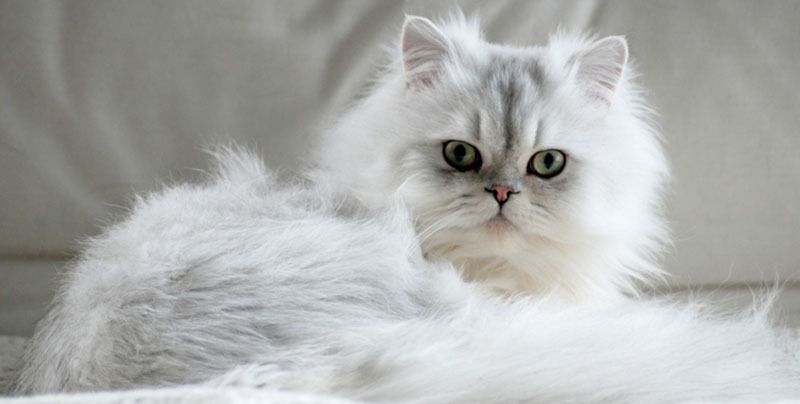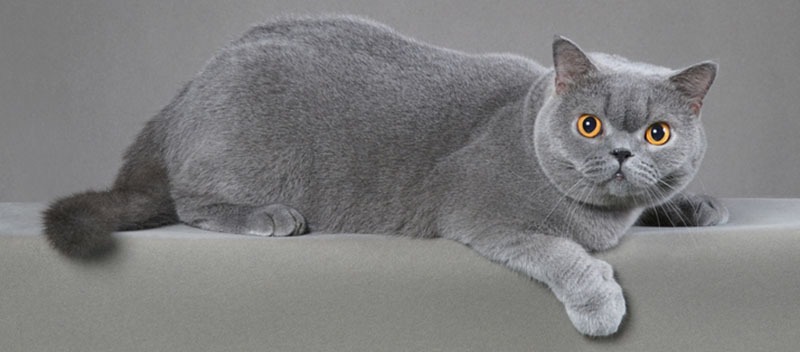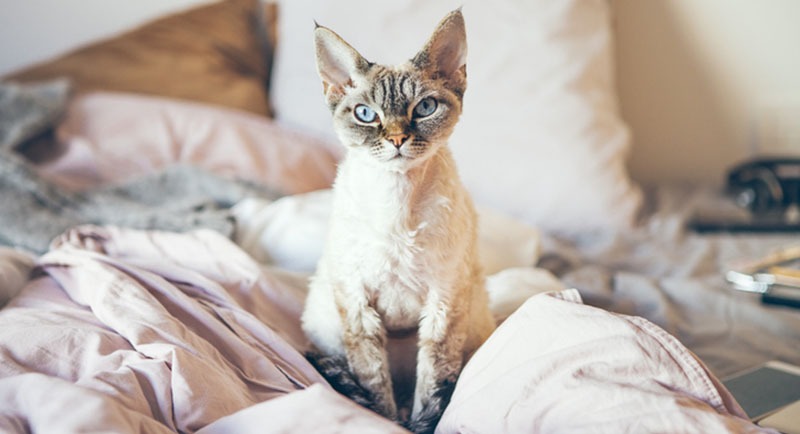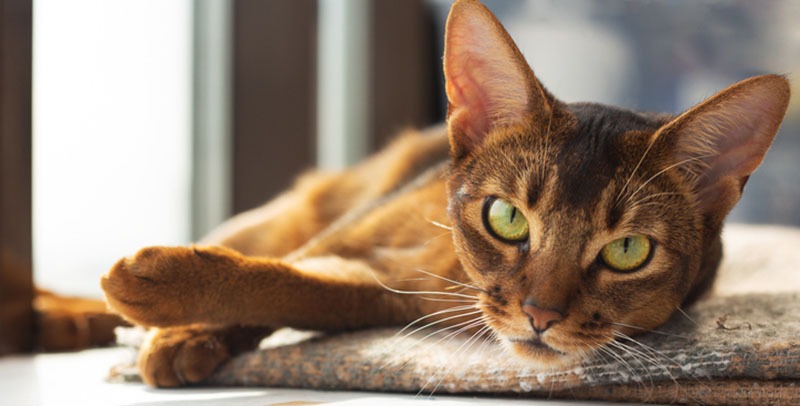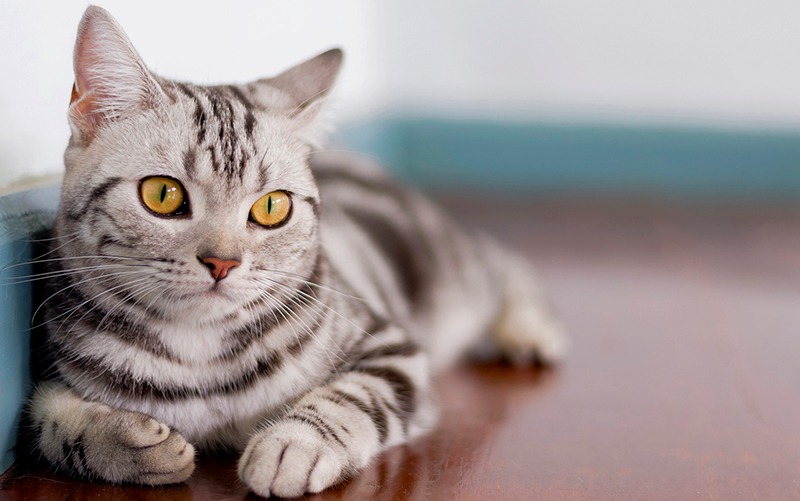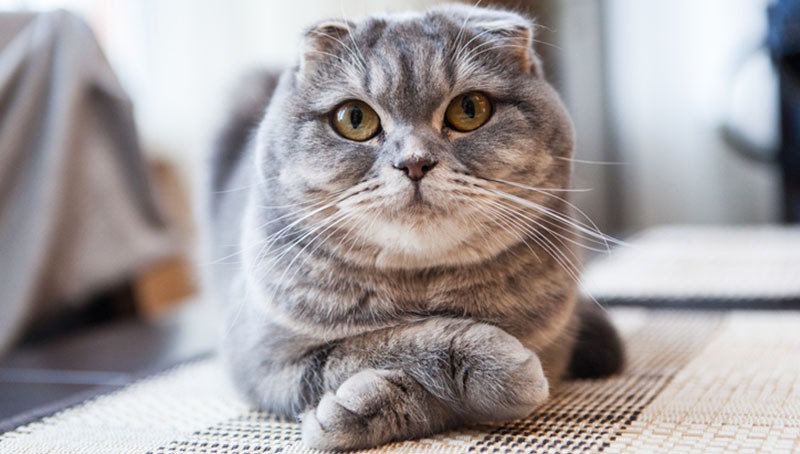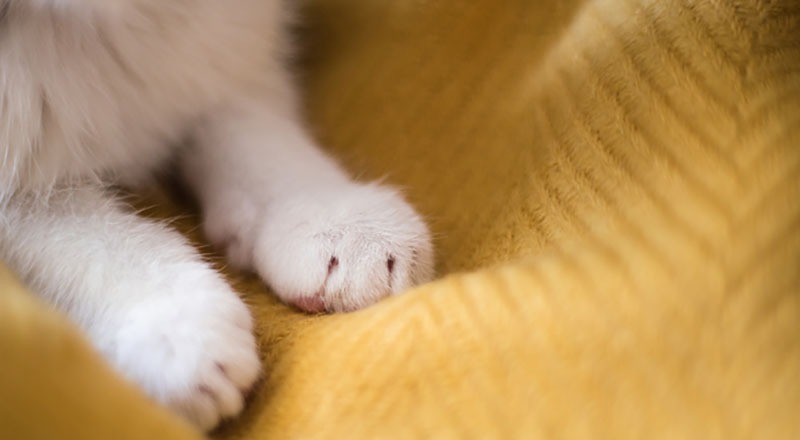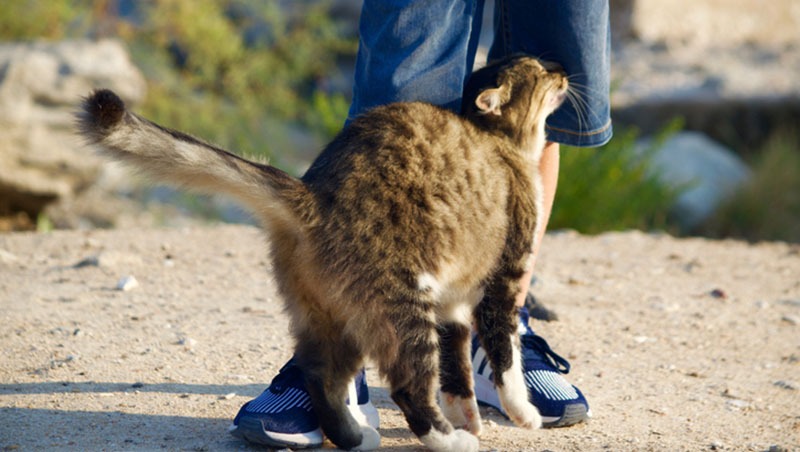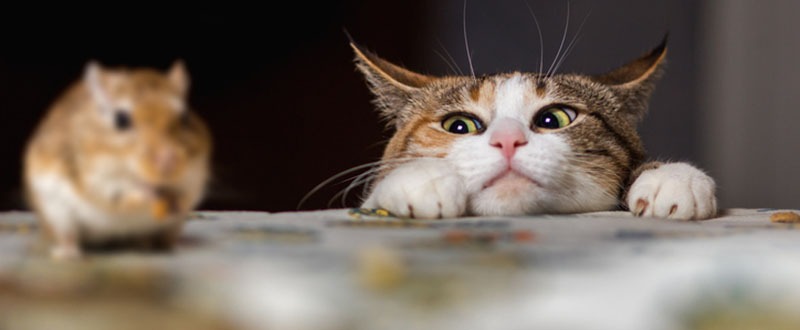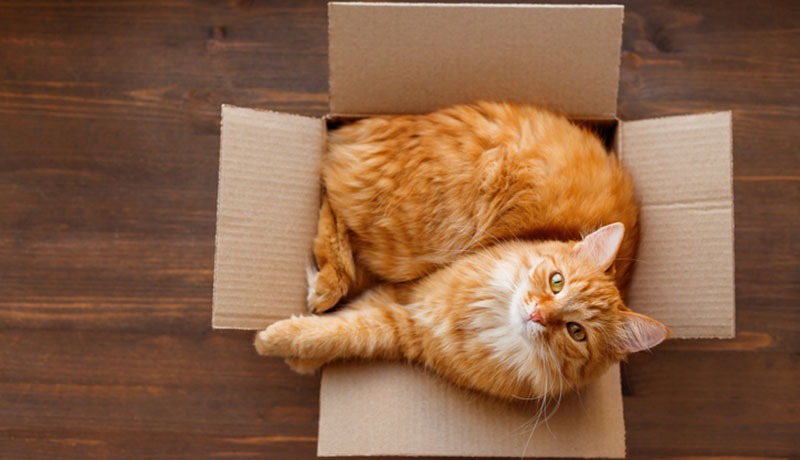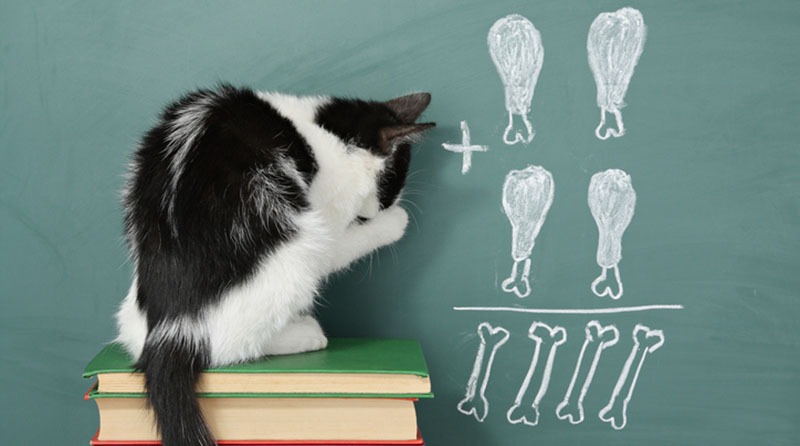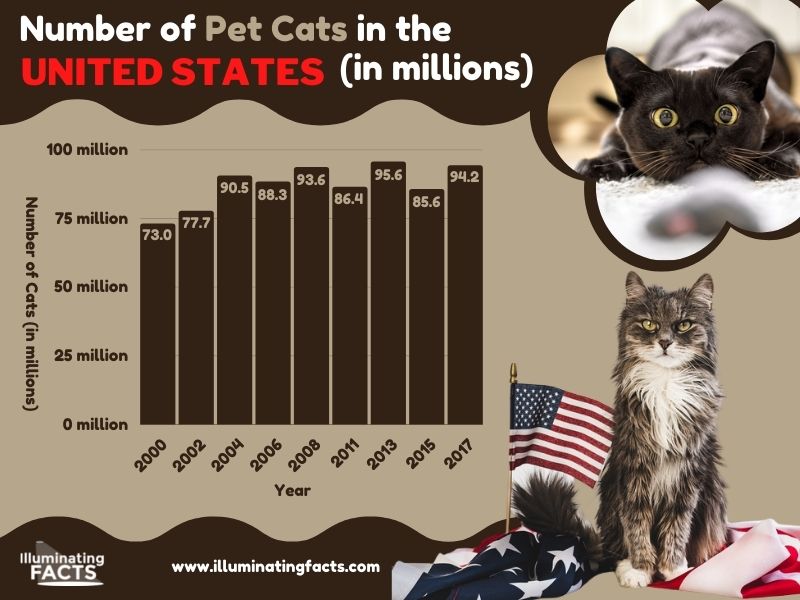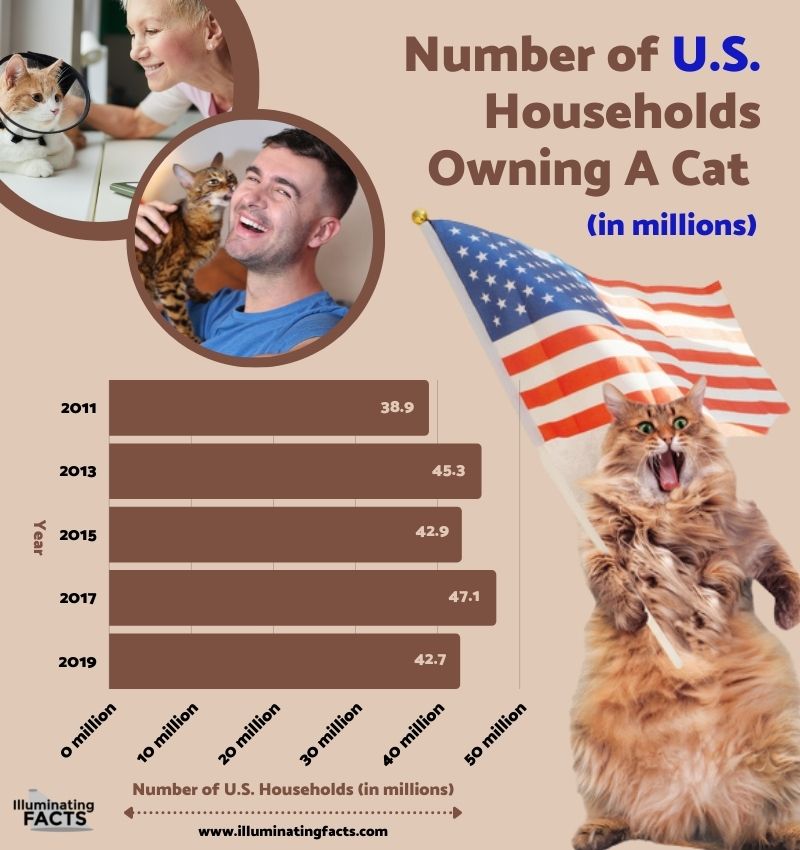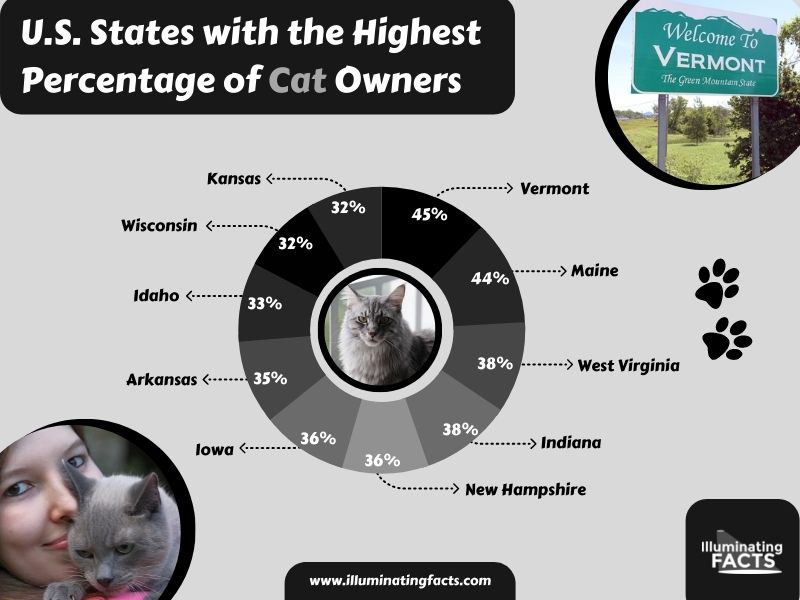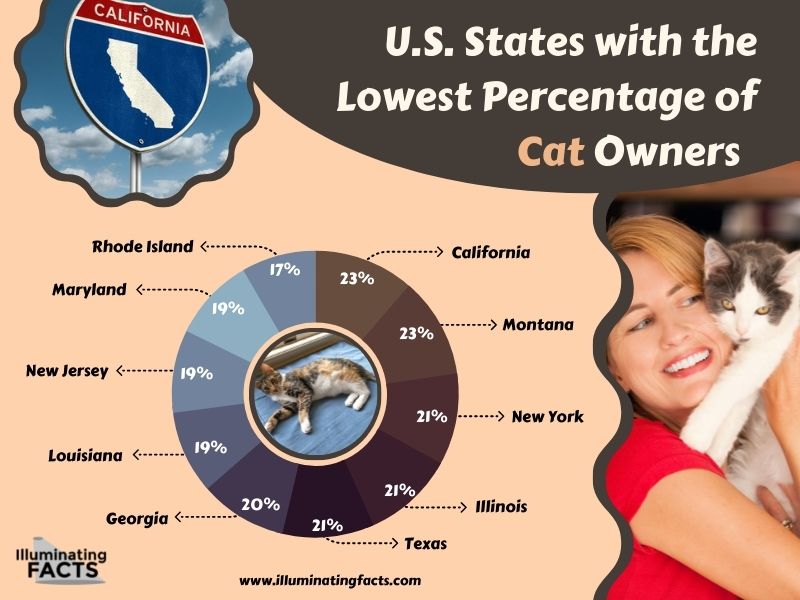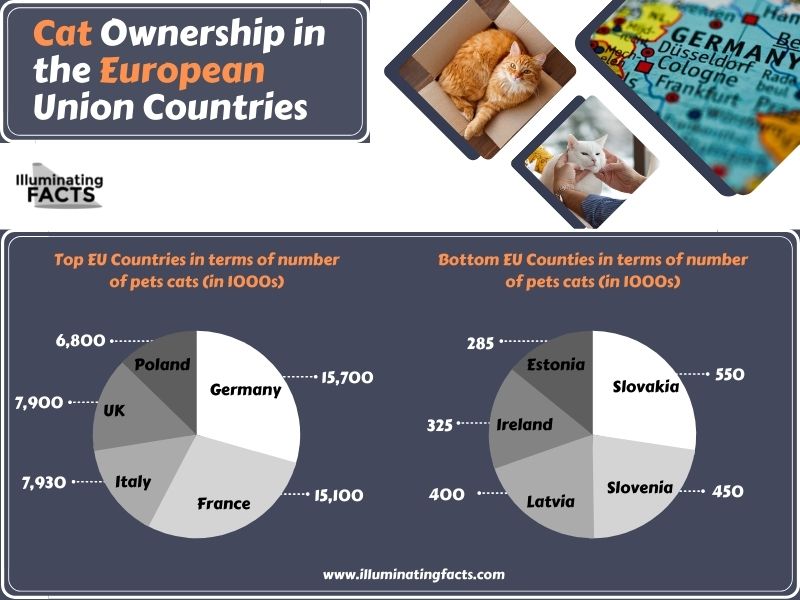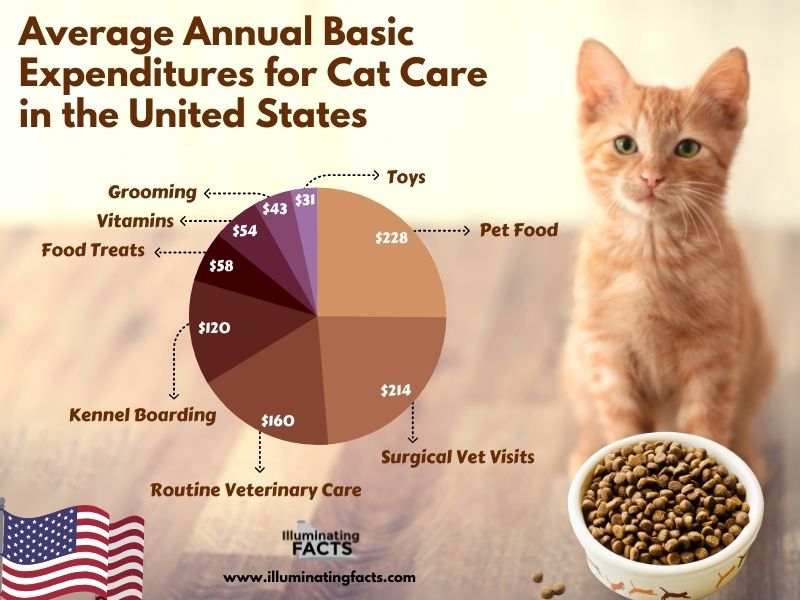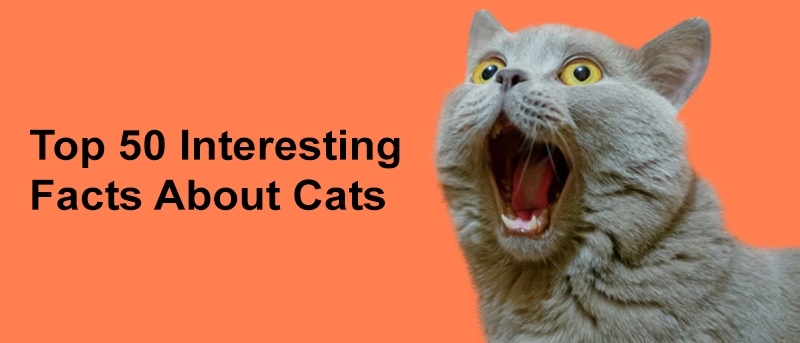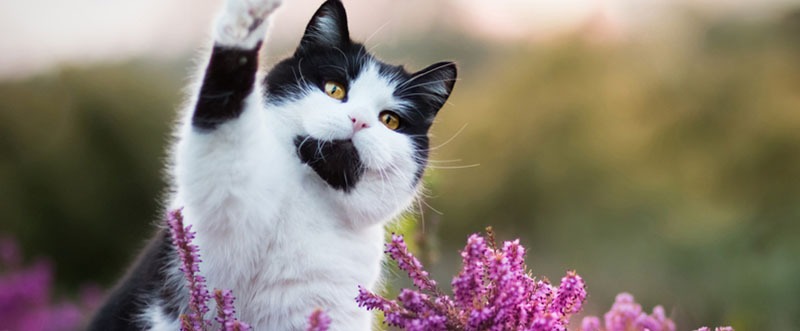Background
Cats are among the most popular pets in the world. They are virtually anywhere, living from homes to apartments, alleyways, and barns. Indeed, these felines have become an integral part of our society, with estimates of more or less half a billion of them living around the world. Many of these cats play distinct roles in humans’ lives – no wonder that we’re also showering them with affection and care.
While they may not have earned the title of man’s best friend, there’s no doubt about the unique bond we have with cats. It’s a partnership that traces from the thousands of years of interaction and connection, transforming what once were feral wildcats into our modern, cuddly, and furry companions.
In this post, we’ll discover more about cats’ fascinating and storied history, evolution, and breeds, as well as humans’ cat ownership and pet care spending. All these will be backed up by essential visualization and numerical data, culminating in a list of fifty interesting facts and rounded up in a meaningful takeaway about this trip to the awesome world of cats.
History of Cats
Cats have established a special relationship with humans at the sprout of the earliest civilization. Yet, while it was previously thought that this bond began during the time of the ancient Egyptians, it was discovered that cats got close to humans when the people started settling and farming during the Neolithic Revolution. Since then, cats have been a mainstay in the ancient towns before they were even revered as sacred animals in Egypt.
Eventually, cats reached other parts of the world, from Egypt to Rome, Europe, and Asia. Thanks to their incredible mousing ability, felines were prized by all nations they set in. Things weren’t as smooth for them, though, as cats had their darkest hours during the Middle Ages, with hundreds of thousands of them killed.
Fortunately, cats recovered and sailed again to other parts of the globe, like the Americas and Australia, got more popular and bred extensively, and even became “heroes” before being the beloved and adorable pets we have today. Let’s discover their fascinating journey in the timeline below.
Overall Timeline
This section will highlight the most important events in the history of cats, thrift domestication, and their relationship to humans.
12,000-10,000 years ago: Feral cats were tamed
During the Neolithic Period, around 12,000 to 10,000 years ago, cats started to establish a relationship with humans in the Fertile Crescent, a boomerang-shaped geographic region in the Middle East where the earliest developments in humanity began. Humans jilted their nomadic, foraging lifestyle and started to settle and form agricultural societies.
With grains and cereals now being cultivated and stored, people’s farmlands attracted unwanted visitors – rodents. The African wildcats (Felis silvestris lybica), the major ancestor of the modern domestic cat, soon followed and enjoyed the increased vermin population. With the new, plentiful food source, the feral cats stayed in these ancient towns and scavenged on humans’ leftovers and garbage, paving the way for these felines’ subsequent domestication. [1][2]
9,500 years ago: A cat was buried alongside a human
In Cyprus, a burial site was discovered with a cat buried side-by-side with a human. It is believed that humans intentionally brought cats to the islands, most likely through boats across the Levantine coast. The archeological evidence serves as proof that feline-human relationships have started far beyond what was initially thought. [3]
9,000 years ago: Cats reached Israel
Archeological deposits dating 9,000 years ago were found containing a molar tooth from a cat. Meanwhile, an ivory cat statue was also discovered in the country, dating 5,300 years later, suggesting that domestic cats have already been familiar companions in villages and homes starting in the Fertile Crescent. [3]
5,300 years ago: China got its own domesticated cat
Few cat bones were unearthed in a Yangshao village in China, dating 5,300 years ago. Pieces of evidence that a separate instance of domestication of cats may have occurred in the region. Yet, further studies reported that the bones discovered belonged to the leopard cat. There’s no additional proof that modern kitties descended from leopard cats. Therefore, suggesting that while people may have tamed cats in China, it was relatively short-lived. [4]
4,000 years ago: Cats were revered in Ancient Egypt
A thousand years later, after the Neolithic Period, the cats found their way to ancient Egypt, where they took on the job of mouse-catchers, guarding the crops and preventing vermin-borne diseases from spreading among people. Thus, improving the Egyptians’ quality of life immensely. Soon, the Egyptians saw cats as more than mere rodent killers but as an insignia of abundance and life. [5]
With their newfound value, cats were revered and widely viewed as magical creatures or divine representations of their gods. To honor them, cats were fed food fit for the royalties and adorned with expensive jewelry to display their special status to their owners. Even by accident, killing a cat was punishable by death, attesting to how special they were to the Egyptians. When felines die, they are mummified. They were then placed alongside their human owner’s tomb with aspirations to continue their relationship and bring good luck in the afterlife. [6][7]
A 4,500-year-old tomb was found in Saqqara, a necropolis in ancient Egypt’s capital, Memphis. Inside it was a bronze statue of the renowned cat goddess Bastet, a hundred wooden feline statues, and dozens of mummified cats. [8] Much earlier, a cat cemetery in Beni-Hassan was discovered, housing 300,000 cat mummies. [9] Apart from those, cats were also prominently featured in art, paintings, patterns, obelisks, and hieroglyphics – proof of how ancient Egyptians were history’s most fervent cat lovers.
3,000 years ago: Cats were introduced to Rome
Ancient Egyptians traded cats to Phoenicians and Greek merchants, resulting in the introduction of felines to Rome. Roman legions also valued cats for their abilities in protecting crops and warding off rodents and diseases. [2] Soon, they served as valuable companions to soldiers, bearing more significance to the latter than just being protectors of their armors and equipment from rats.
Like ancient Egyptians, Romans also eventually held high esteem for cats. Cats were associated with Libertas, the goddess of liberty and freedom. They were the only animals allowed to enter temples but were also sacrificed at weddings and funerals for prosperity and protection. [10][11]
2,000 years ago: Asia welcomed cats
Around 2,000, the domesticated cats from the African wildcat lineage reached Asia through the trade routes. Genetics played its role, giving birth to other natural breeds, such as the Siamese and the Korat cats. [3]
400 A.D.: Romans brought cats to Europe
As the Romans began to conquer other nations, cats were also introduced to other parts of Europe, including Britain. Nothing has changed with the primary role of cats, with the Britons also utilizing them for crop and rodent protection. When the Romans finally left Britain, most of the cats they owned were left in Britain. Vikings then invaded the country and took some cats to Norway, further spreading cats across Europe. [2]
The Middle Ages: Europe demonized cats
Sadly, the Middle Ages saw a dramatic downturn in images of cats, making it one of the challenging periods for these animals. From being revered as sacred animals, cats were associated with evil, superstition, and witchcraft.[2]
The event is traced to the rise of Christianity, which had the practice of detesting its religious opponents. Most gods and goddesses were disparaged and demonized, including deities linked to cats. [12] In the 1230s, Pope Gregory IX released Vox in Rama, a papal bull that associated cats with witchcraft and satanism.[13]
Throughout the Middle Ages, cats were treated badly and ritualistically tortured. They were burned, thrown out of buildings, and beaten to death. [14] It was a horrendous time for cats, with hundreds of thousands of them being massacred. Black cats had it the worst, as they were the ones believed to be used in witchcraft. These felines were executed along with those suspected of doing dark magic.[15]
Many people deemed that those events resulted in the boom of the rat population in Europe, allowing the quick spread of the Bubonic Plague that killed more or less half of the human population in the region. [2][12]
15th and 16th centuries: Cats sailed to the New World
In the 15th and 16th centuries, cats’ reputations started to recover and gained popularity. Traders and explorers from Britain and Spain reached the Americas, where they found a huge plague of rats. They brought cats on their large ships, as without them on board, the crew would have died of starvation or been sick with diseases carried by the rats. It then led to the introduction of cats in North and South America, enabling cats to reach more and more land and be adored by the American people.[16][17]
The 1800s: Cats became popular in Britain
Recovering from their dark history, cats started to grow in popularity in Britain by the 1800s. In 1871, the first exhibition of purebred cats took place in Crystal Palace in London, resulting in more breeds being developed. With cats already useful at the onset of their relationship with humans, selective breeding was rather pointed to enhancing their beauty, such as their coat’s color, markings, and texture, rather than providing them other utilitarian skills. [18][19][20]
The late 1800s: European cats brought cats to Australia
Researchers concluded that Australia got its cats from the ones brought by the European settlers in the late 19th century. Like how they reached the New World, cats have boarded sailing vessels to these new settlements. While there’s another theory that Malaysian trepangs (sea cucumber fishers) brought cats to the islands in 1650, analysis of feral cat populations traced the roots to the cats that arrived with the European explorers. [21]
1906: Cat Fanciers Association was founded
The Cat Fanciers’ Association (CFA), the oldest cat registry in the United States and currently the world’s most prestigious cat registering association, was founded in 1906. Its first shows were held in Buffalo, New York, and Detroit, Michigan. In the same year, it published its initial Stud Book and Register in the Cat Journal. As of 2021, the CFA recognized 46 pedigreed breeds.[22]
1914-1918: Cats became “heroes” during WW1
During WW1, cats played a bigger purpose, with half a million felines released through the trenches. Their primary roles were to control rats and sniff poisonous gas. Apart from fulfilling those tasks, they served as mascots for the lonely soldiers, who would play with them during the respites of the war. By the end of the global conflict, cats had already found their way into many households all over the world. [23]
Today: Cats continue to have a special part in humans’ lives
Despite having gone through a lot in their history with humans, cats kept their special relationship with us and continue to be an integral part of society, homes, and hearts – something that they are undoubtedly set to do in the future.[15]
A Summary
The overall timeline of the History of Cats is illustrated in the image below.
Origins of the Most Popular Cat Breeds
As cats reached new places, it resulted in the development of natural regional variants. Of course, intervention from humans through selective breeding also happened, giving birth to more fancy breeds by maintaining or altering only the aesthetic traits. [24] Here, let’s go back in time and have a look at the unique and astonishing origins of the cat breeds from CFA’s Most Popular List for 2020. [25]
1. Ragdoll
Ragdolls are laid-back, endearing, and gorgeous cats with charming blue eyes and soft, silky coats. They were only developed in the 1960s, thanks to the work of American breeder Ann Baker. The breed’s roots trace nearly purely to free-roaming cats, which Baker discovered in her neighborhood in Riverside, California. She found Josephine, a white, longhaired female cat, and bred it to the other cats she earlier owned. Josephine’s offspring boasted unique temperament traits. Baker selectively bred those possessing the characteristics she liked for her breeding program and created the Ragdolls we have today.[26]
2. Exotic Shorthair
Another recently developed breed, the Exotic Shorthair, was only created in the 1950s by crossing the American Shorthairs to Persians. The original intent was to produce an American Shorthair, with its silver coat and green eyes but resembling a Persian. While the resulting offspring weren’t what they expected, the kittens were very lovely, having the appearance of the Persian cat but the short, plush coat of the American Shorthair. Other breeders bred the Persians to the Burmese and Russian Blues to get the same result, leading to additional coat colors. The CFA formally recognized the breed in 1967. [27][28]
3. Maine Coon
The Maine Coon is one of the largest domesticated cats, originating from Maine. It’s a natural breed that has adapted to the state’s harsh, chilly winters and wild environment. Yet, there’s a myth that links its origins to a forbidden love affair between a longhaired feline and a raccoon, resulting in the breeds’ resemblance to the latter.
On the other hand, another story says that the breed arrived in the United States through Viking ships, given the Maine Coon’s similar appearance to the Norwegian Forest Cat. Nevertheless, what’s certain is that the Maine Coon has been long adored and considered the “Gentle Giant” of the cat fancy.[29][30]
4. Persian
One of the world’s oldest and most popular cat breeds, the Persian cat’s origin dates back to the 1600s. Though their exact beginnings are forever shrouded, the breed was deemed to have emerged in Mesopotamia, later on, called Persia (where the breed got its name), and now modern-day Iran. European explorers were said to have brought Persian cats out of Iran to England, where the breed has been an immediate hit among the royals. Eventually, Persian cats spread throughout Europe and reached North America. [31][32]
5. British Shorthair
Perhaps the oldest English cat breed, the British Shorthair’s lineage can be tracked down to the domestic cats brought by the Roman legions. When the empire collapsed, the cats were left in Britain. The Victorian Era then came when breeding pedigreed cats became a fancy. From street cats roaming the UK, breeders selected the best individuals, and with lots of hard work resulted in the British Shorthair that’s much-loved not only in Britain but in many other parts of the world.[33][34]
6. Devon Rex
Dubbed as the “Pixie Cat of the Cat Fancy,” the Devon Rex is renowned for its oddly shaped head, long, skinny neck, soft, wavy coats, expressive eyes, and conspicuous batwing ears. While the breed may seem like it originated from some other place in space, its appearance is actually due to a natural mutation.
In the late 1950s, Bernyl Cox found a stray tomcat with a curly coat and bred it to one of her female cats. The resulting kitten was named Kirlee, deeming it carried a similar gene as the Cornish Rex. Later on, it was found out that the Devon Rex had a different one, as it had a more unkempt curly coat and low-lying ears, rather than the latter’s uniform waves and high-set ears. The Devon Rex first reached the United States in 1968 and was recognized by the CFA more than a decade after in 1979.[35][36]
7. Abyssinian
The Abyssinian is another breed with shrouded origins. The myth says these felines were once owned by the Pharaohs – no surprise as they resemble the ones portrayed in Ancient Egyptian sculpture and paintings. Meanwhile, many believe that the cat got its name from Zula, the Abyssinian cat exhibited at the Crystal Palace, which was said to be imported from Abyssinia (modern-day Ethiopia).
The most credible origins were the recent genetic studies tracing the breed’s roots from the Indian Ocean’s coast and southeast Asia. The first identifiable Aby, a taxidermied cat exhibited at Holland’s Leiden Zoological Museum, originated from India, supporting the theory. The Aby was first imported to the U.S. in the 1900s, but extensive programs only began three decades later.[37][38]
8. American Shorthair
Prized for its mousing ability, the American Shorthair descended from the hardworking European cats that boarded ships, like the Mayflower, and landed in the Western Hemisphere in the 1600s. For many centuries, they helped barns, food stores, and homes stay clear of rodents. Thus, eventually earning themselves status as the native American shorthaired cat. In 1906, these felines were one of the first five breeds recognized by CFA. Initially called the “Domestic Shorthair,” but was later renamed the “American Shorthair” in 1966.[39][40]
9. Scottish Fold
As the breed’s name suggests, Scottish Folds originate from Scotland, specifically in the Tayside Region, Northwest of Dundee. A shepherd named William Ross found Susie, a barn cat with folded ears in 1961. Ross acquired one of Susie’s kittens and began the development of Scottish Folds with the quickly recognizable lopped ears. CFA recognized the breed in 1978. However, it isn’t recognized in Scotland, its country of origin, due to concerns that the iconic ears may cause cartilage issues, deafness, and ear infections. [41][42]
10. Sphynx
While the breed’s name may seem like it came from Egypt, the Sphynx actually traces its origins in Canada. A domestic cat gave birth in 1966, and one of her offspring was a “hairless” kitten, which was found to be a natural mutation. The breeding program began, giving the Sphynxes that we know today. This breed is not totally hairless but possesses a down of varying degrees. These cats are extremely adorable, often displaying silly antics, getting clumsy, or throwing inquisitive looks – no wonder that cat enthusiasts across the world adore them. [43]
Demystifying Cats’ Behavior
Cats are mysterious creatures, especially when compared to dogs, the man’s best friend. While the latter are obedient, friendly, and faithful, felines tend to be more independent and aloof. [44] Cats are also more subtle and have distinct ways of displaying their affection. [45] Not to mention, they also do lots of strange behaviors that may appear odd to humans. In this section, we’ll decode some of the cats’ puzzling ways to know more about their inner world.
Why do cats purr?
Most people think that cats purr when they’re happy. However, there are various reasons why they do so. It all starts when they are kittens. As they are born blind and deaf, kitties use purring to let their mother be aware of their location, entice her attention during feeding time, and persuade her to keep nursing them. Cats carry such behavior into adulthood, which is why they purr during dinner time or when a person strokes them to elicit further interaction.
Cats also use purring to seek help. A study reported that felines mask a cry in their purr to stimulate the nurturing instincts of their beloved owners. Other research said that vibrations from purring are self-soothing or healing for cats, explaining the reason behind their purring after a stressful event or an injury. [46][47]
So, how do cats purr? A purr is a form of vocalization from the rapid movement of the cat’s larynx or voice box, combined with the movement of the diaphragm. As a feline breathes in and out, the air touches the moving muscles. Thus, creating the purring sound.[48]
Why do cats knead?
Cats often “knead” or press their paws onto their owners and massage them back and forth. This habit is another behavior that traces to their earliest days. Newborn kittens knead their mom’s mammary glands to trigger milk production. It again continues into their adulthood, but various theories surround why they do so.
First, it’s believed that kneading is soothing for them, bringing them back to the pleasurable moments they had as kittens. Whenever they knead, it implies that they’re happy and content or trying to create a calm mood. Whatever the reason is, it serves as a complement to the owner as it means that the cats think of him or her as their mom.
Another theory suggests that cats knead to get a comfortable resting place, comparable to how dogs circle down before lying down. Their wild ancestors created nesting spots out of leaves and grasses, and this behavior is a continuing “wild” instinct. Lastly, it is also believed that cats knead to mark their territories. Felines have scent glands in their paws and pressing them on certain spots leaves their scent, signaling they’ve been there.[49][50]
Why do cats love cheek rubs and head butts?
Another common habit of cats is showering their owners with cheeks rubs and head butts. Truth to be told, both are their ways to show their affection. Also called “bunting,” it’s a social behavior where felines try to mark their human caretakers and inanimate objects with their scent to make them smell more like a cat. Cats actually have glands on their heads that release pheromones. Passing and mingling this scent with others, they show ownership and take pride in their possession – their own unique way of saying “I love you!” [51]
Why do cats bring “gifts”?
There are various theories why cats bring their kills, like mice, birds, and insects into their homes, and give them as “presents” to their owners. First, it’s believed that cats view their owners as poor hunters, and giving these gifts is their way to provide sustenance for them or show their care and love. Others suggest that the behavior is felines’ way of acknowledging humans as a part of their group and simply want to share their triumph, request attention, or show gratitude or payback for giving them food and shelter. [50][52]
Why do cats like to gnaw or lick power cords, plastic bags, and nonfood stuff?
Cats seem to have a unique fondness for plastic bags, but the reason behind has never been convincingly explained. Some suggest it provides a special sensory experience for cats due to its smooth feel, rumpling noise, and distinct taste of plastics. Others say cats licking or chewing harder plastic items and other non-food stuff, like fabric, paper, or stuff animals, is an attempt to relieve stress, a sign of dietary deficiency or medical condition, or simply boredom. [46][51][53]
Why do cats love boxes?
Despite having more comfortable places in the house like the couch or their own cat bed, many cats still prefer to curl up and sleep in boxes, cramming themselves even in the smallest ones. Well, cats do that to feel protected. If they’re out in the wild, sleeping in an open area isn’t ideal, as it makes them vulnerable to predators. They carry that mindset even inside homes. Cats also have the innate instinct to ambush, and boxes serve as a great hiding place where they can first observe others before “attacking.”
As felines lack the inherent conflict resolution skills, they try to combat stressful events through running and hiding. Boxes are ideal for them as it serves as their safe, private, enclosed refuge. Lastly, these spaces are also great insulators, providing them warmth and making them just perfect for the cats’ secure, comfy sleep.[50][54]
Cats By The Numbers
This section will cover all the numbers and data associated with the cat world, from the population, cat ownership, and primary pet source to cat care expenditures. All these are supported by graphical illustrations and charts for a quicker understanding of the significant numbers revolving around our beloved felines.
Number of Pet Cats in the United States
Based on APPA’s American Pet Products Association (APPA) National Pet Owners Survey last 2000, approximately 73 million cats were living in American homes. It rose to 4.7 million in 2002, and a massive 12.8 increase in 2004. However, that was the last consecutive increase as the population growth trend had gone up and down in the subsequent years. From 90.5 million cats owned by Americans in 2004, it plunged to 88.3 million in 2006 before rising again to 93.6 million. As of 2017, 94.2 million pet cats were in the United States, a 21.2 increase in nearly two decades.[55][56]
Number of U.S. Households Owning A Cat
As per APPA, 42.7 million households in the United States own at least one cat as of 2019. In 2011, there were only 38.9 million, showing nearly 4 million additional households owning a cat. The most significant numbers were reported in 2017 and 2013, with 47.1 million and 45.3 million, respectively. Like the pet cats population, the trend has been on an upward-downward slope throughout the years. [57]
Cat Ownership in the U.S. States
Vermont (45%) is the state with the highest percentage of cat owners, according to the American Veterinary Medical Association’s study in 2016. It is followed by Maine (44%), West Virginia and Indiana (38%), New Hampshire and Iowa (36%). States with the lowest cat ownership percentage were Georgia (20%), Maryland, New Jersey and Louisiana (19%), and Rhode Island (17%). [58]
Total Number of Pet Cats in the European Union
Cats are the most popular pets in Europe, with nearly 110.15 million pet cats compared to only almost 90 million pet dogs as of 2020, as per Statista. [59] In 2010, there were 84.71 million pet cats on the continent. It has been steadily on the rise since then, increasing to 89.77 million, 99.19 million, and 102.74 million in 2012, 2014, and 2016, respectively. A minimal half a million decrease was recorded in 2018, but figures were again rising since then. [60]
Cat Ownership in the European Union Countries
Germany leads the list of cat owners in the European Union with 15.7 million household felines as of 2020, as per Statista. France follows with 15.1 million and Italy with 7.93 million. Latvia, Estonia, and Ireland have the lowest number with only 400,000, 325,000, and 285,000 pet cats.[61]
Cat Ownership in Asia
In a survey conducted by Rakuten, over half of Asian households own a pet at 59%. Indonesia has the biggest cat ownership percentage at 47%, followed by the Philippines and Thailand with 43% and 42%. Countries with the lowest cat ownership rates are Japan at 11%, Singapore at 10%, and South Korea with only 9%.[62]
Primary Sources where Pet Cats are Obtained in the United States
As per APPA’s 2019-2020 survey, the majority of the cat owners in the U.S. (43%) got their household felines from shelters or rescues. 21% took strays and another 21% acquired them from their friends and family. Only 12% purchased from stores, while the remaining 3% got their cats from breeders.[63][64]
Average Annual Basic Expenditures for Cat Care in the United States
The average annual spending for cat care in the United States is $908 as of 2020, based on APPA’s survey for 2019-2020. Pet food takes the biggest share at $228, followed by surgical visits at $214 and routine visits at $160. Grooming aids at $43 and toys at $31 were the lowest expenditures.[56][65]
- Félicette was the first feline sent to space. She was chosen among the 14 cats summoned by France for their space mission. In 1963, she was blasted from Earth and took a 15-minute journey in space. Félicette survived the trip but died two months later after the scientists removed the electrodes implanted on her brain, used to investigate the effects of spaceflight on the control center of the body. [66]
- Cats are incredible jumpers. They can jump up to six times their length.
- Clowder is the term used to denote a group of cats.
- Cats have a total of 230 bones. Humans have only 206.
- “Felix the Cat” is the first cartoon feline. His first appearance was in 1919 during the silent film era.
- Cats are not nocturnal but are rather crepuscular. That means their active time is during dawn and dusk.
- Two-thirds of a cat’s life is spent sleeping. Felines sleep between 13 and 16 hours a day, though it’s not in any way a form of laziness. It’s a common behavior for predatory animals like the wild cats they’ve descended from.
- During the times they’re awake, cats can be mostly seen grooming themselves. This behavior, however, doesn’t trace to purely vanity or hygiene. They lick their fur due to many helpful benefits, such as cooling themselves down, spreading natural oils on their coat, and encouraging blood flow.
- Cats can produce over 100 vocalizations, varying in cries, meows, and growls.
- As their jaws can’t move sideways, cats are unable to chew large food chunks.
- Cats only have four toes on each of their back paws, which means they only have 18 toes in total.
- Cats can’t taste sweetness and are believed to be the only mammals that can’t do so. Scientists deemed it’s because of a mutation in the feline’s key taste receptor.
- Around 400,000 cat bites occur in the U.S. annually.
- On average, cats give birth to a litter of one to nine kittens. The most number born by a feline was 19, 15 of the kittens survived.
- The Siberian Tiger is the world’s largest wild cat, growing 12 feet long and weighing around 700 pounds.
- Cats have 24 mystacial whiskers or 12 on each cheek. However, they also have whiskers above their eyes, chin, upper lip, backs, and back of their legs.
- Whiskers are very useful for cats as these let them “see” in some sort. As whiskers touch objects or get moved by airflow, signals are transmitted to the nervous system, allowing cats to gauge what’s around them.
- A human’s back only has 34 vertebrae. A cat’s back has 53, making it extremely flexible.
- Felines walk by moving both right feet first, then both left feet. This special walking sequence is only done by two other animals: camels and giraffes.
- Cats’ paws have lots of nerve receptors, making them extremely sensitive. As such, they can use it in processing various information like vibrations, temperature, and pressure.
- A cat’s nose print is unique. Just like humans’ fingerprints, no two felines can have identical nose prints.
- A cat’s heart beats 110 to 140 times each minute, nearly twice that of a human’s.
- A male cat is regarded as a tomcat, while a female cat is referred to as molly or queen.
- Researchers say that cats know their name – but just don’t care.
- A cat named Andy holds the record for the longest non-fatal fall. He fell 200 feet from the 16th floor of an apartment but survived.
- Cats can drink salt water, if necessary, to survive.
- While humans only have six, 32 muscles that control a cat’s outer ear. Thus, they can rotate it 180 degrees.
- In Scotland, a commemorative statue was built to honor a cat named Towser, who caught around 30,000 mice in his whole lifetime.
- A cat lover is called an ailurophile.
- Catnip is believed to produce the same effect as marijuana or LSD on cats.
- Direct eye contact from humans makes cats uncomfortable, intimidated, or threatened.
- Cats feel warmer because they have a higher normal temperature than humans, ranging between 100 and 102 degrees.
- Kittens can be spayed or neutered as young as eight weeks old.
- Isaac Newton invented the cat door. While doing experiments in a pitch-black room at the University of Cambridge, his cat named Spithead kept on clawing at the door, ruining his experiment. As such, he asked a carpenter to create the cat flap, which remains an incredibly useful realization.
- Just like humans, cats also dream.
- Cats only sweat through their paw pads. If they’re too sweaty, it implies that the cat may be nervous, stressed, or overheating.
- All cats, including big cats, can retract their claws – except for the cheetahs.
- Female cats tend to be right-pawed, while male cats are usually left-pawed.
- Female cats can already get pregnant at around four months of age.
- Creme Puff is the oldest cat to have ever lived. He was born in 1967 and died in 2005 at the age of 38 and three days.
- While most cartoon shows depict cats as raw fish lovers, cats must not eat raw fish. It contains bacteria that could lead to food poisoning.
- Most cats like cantaloupe as it has many amino acids present in meat, making it smell just like meat.
- Cats only have roughly 470 taste buds. Humans have approximately 9,000.
- Turkish Van cats have water-resistant coats – no surprise that they love swimming.
- Cats can run approximately 31 miles per hour (49 kilometers) over a short distance.
- Felines have a better night and peripheral vision than humans.
- While the reason isn’t clear, raisins and grapes can cause kidney failure in cats. Meanwhile, chives, garlic, and onions ruin their gastrointestinal tract and cause anemia.
- There’s a cat reality TV show in Iceland titled “Keeping Up With the Kattarshians” featuring four kittens confined in a Big Brother-style cat house.
- Cats don’t have similar taboos when it comes to incest, meaning they can mate with their siblings and mothers. One of the results of inbreeding is that the feet may grow extra toes.
- Cats use their tail for balancing, such as when walking along thin ledges or when jumping.
Final Words
From being feral to being employed rodent killers, from being divine animals to being demonized, and then rising again and conquering the world and our homes, cats undoubtedly have a fascinating, storied history. Today, we continue to offer the same affection and appreciation for these felines they got in most of their time. In return, they serve as our beloved pets and companions, enriching our lives in their own mysterious and wondrous ways.
References
[1] The History of the Domestic Cat. Alley Cat Allies. (n.d.). Retrieved October 21, 2021, from https://www.alleycat.org/resources/the-natural-history-of-the-cat/.
[2] The History of The Cat. Omlet UK . (n.d.). Retrieved October 21, 2021, from https://www.omlet.co.uk/guide/cats/the_history_of_the_cat/.
[3] Zielinski, S. (2009, May 27). The Cat’s 10,000-Year Journey to Purring on Your Lap. Smithsonian.com. Retrieved October 21, 2021, from https://www.smithsonianmag.com/science-nature/the-cats-10000-year-journey-to-purring-on-your-lap-12116456/.
[4] How did cats become domesticated? The Library of Congress. (n.d.). Retrieved October 21, 2021, from https://www.loc.gov/everyday-mysteries/item/how-did-cats-become-domesticated/.
[5] The Origins Of Cats. International Cat Care. (2018, October 15). Retrieved October 21, 2021, from https://icatcare.org/advice/the-origins-of-cats/.
[6] Cats Rule in Ancient Egypt. National Geographic Kids. (n.d.). Retrieved October 21, 2021, from https://kids.nationalgeographic.com/pages/article/cats-rule-in-ancient-egypt.
[7] Yuko, E. (2021, August 17). How Cats Became Divine Symbols in Ancient Egypt. History.com. Retrieved October 21, 2021, from https://www.history.com/news/cats-ancient-egypt.
[8] Daley, J. (2018, November 12). Tomb Full of Sacred Cats and Beetles Found in Egypt. Smithsonian.com. Retrieved October 21, 2021, from https://www.smithsonianmag.com/smart-news/tomb-full-cats-and-scarab-found-egypt-180970786/.
[9] Zax, D. (2007, June 30). A Brief History of House Cats. Smithsonian.com. Retrieved October 22, 2021, from https://www.smithsonianmag.com/history/a-brief-history-of-house-cats-158390681/.
[10] Harrison, K. (2013, February 4). Cat Folklore: Cats Ruled Ancient Rome. Fully Feline. Retrieved October 22, 2021, from https://fullyfeline.com/cat-folklore-cats-ruled-ancient-rome/.
[11] Um, S. (n.d.). Cats in the Ancient World. Fussie Cat. Retrieved October 22, 2021, from https://fussiecat.com/cats-in-the-ancient-world/.
[12] Feenstra, J. (2020, February 6). The Cat in Medieval Western Europe. LeidenArtsInSocietyBlog. Retrieved October 22, 2021, from https://www.leidenartsinsocietyblog.nl/articles/the-cat-in-medieval-western-europe.
[13] Ward, J. (2021, April 17). Did Pope Gregory IX’s Hatred of Cats Lead to the Black Death? Medium. Retrieved October 22, 2021, from https://medium.com/illumination-curated/did-pope-gregory-ixs-hatred-of-cats-lead-to-the-black-death-327d163adfb2.
[14] Carlton, G. (2017, October 1). People In The Middle Ages Hated Cats So Much That They Ritualistically Tortured Them. Ranker. Retrieved October 22, 2021, from https://www.ranker.com/list/cat-fairs-in-the-middle-ages/genevieve-carlton.
[15] Cvetkovska, L. (2020, June 6). A Brief History of Cats: From the Wildcat to the House Cat. Petpedia. Retrieved October 22, 2021, from https://petpedia.co/history-of-cats/.
[16] The History of Cats Explained. Cats.Org.Uk. (n.d.). Retrieved October 22, 2021, from https://education.cats.org.uk/media/1286/com_3474-brief-history-of-cats-infographic.pdf.
[17] Vera, S. (2018, September 26). Cats And The New World. PrettyLitter. Retrieved October 22, 2021, from https://www.prettylitter.com/blog/cats-or-columbus-who-s-the-real-hero.
[18] How Were Cat Breeds Created? Basepaws. (2020, October 27). Retrieved October 23, 2021, from https://basepaws.com/blogs/news/how-cat-breeds-were-created.
[19] Briggs, H. (2017, June 19). How cats conquered the ancient world. BBC News. Retrieved October 23, 2021, from https://www.bbc.com/news/science-environment-40306897.
[20] The origin of Cat Breeds. Mondou. (n.d.). Retrieved October 23, 2021, from https://www.mondou.com/en-CA/advice/the-origin-of-cat-breeds.
[21] Where did Australian cats come from? ScienceDaily. (2015, December 4). Retrieved October 23, 2021, from https://www.sciencedaily.com/releases/2015/12/151204000229.htm.
[22] About CFA. The Cat Fanciers Association Inc. (n.d.). Retrieved October 23, 2021, from https://cfa.org/cfa-history/.
[23] Milzarski, E. (2021, April 28). Why cats were the perfect companions in the trenches of WWI. We Are The Mighty. Retrieved October 23, 2021, from https://www.wearethemighty.com/mighty-history/cats-wwi-trench-companion/.
[24] Lipinski, M. J., Froenicke, L., Baysac, K. C., Billings, N. C., Leutenegger, C. M., Levy, A. M., Longeri, M., Niini, T., Ozpinar, H., Slater, M. R., Pedersen, N. C., & Lyons, L. A. (n.d.). The Ascent of Cat Breeds: Genetic Evaluations of Breeds and Worldwide Random Bred Populations. Genomics. Retrieved October 23, 2021, from https://www.ncbi.nlm.nih.gov/pmc/articles/PMC2267438/.
[25] The Cat Fanciers’ Association Announces Most Popular Breeds for 2020. The Cat Fanciers Association Inc. (2021, February 25). Retrieved October 23, 2021, from https://cfa.org/cfa-news-releases/top-breeds-2020/.
[26] About the Ragdoll. The Cat Fanciers Association Inc. (n.d.). Retrieved October 23, 2021, from https://cfa.org/ragdoll/.
[27] Jimerson, D. (n.d.). Exotic Shorthair. Daily Paws. Retrieved October 23, 2021, from https://www.dailypaws.com/cats-kittens/cat-breeds/exotic-shorthair.
[28] Exotic Shorthair Cat Breed information. Vetstreet. (n.d.). Retrieved October 23, 2021, from http://www.vetstreet.com/cats/exotic-shorthair#0_wxcme02m.
[29] C, P. (n.d.). Maine Coon Cat Facts. ASPCA Pet Health Insurance. Retrieved October 23, 2021, from https://www.aspcapetinsurance.com/resources/maine-coon-cat-facts/.
[30] About the Maine Coon Cat. CFA. (n.d.). Retrieved October 23, 2021, from https://cfa.org/maine-coon-cat/.
[31] Encyclopedia.com. (n.d.). Persian Cats. Encyclopedia.com. Retrieved October 24, 2021, from https://www.encyclopedia.com/humanities/encyclopedias-almanacs-transcripts-and-maps/persian-cats.
[32] About the Persian. The Cat Fanciers Association Inc. (n.d.). Retrieved October 24, 2021, from https://cfa.org/persian/.
[33] About the British Shorthair. The Cat Fanciers Association Inc. (n.d.). Retrieved October 24, 2021, from https://cfa.org/british-shorthair/.
[34] British Shorthair Cat Breed Information. Vetstreet. (n.d.). Retrieved October 24, 2021, from http://www.vetstreet.com/cats/british-shorthair#1_ugw20zmq.
[35] Devon Rex Cat Breed Information. Vetstreet. (n.d.). Retrieved October 24, 2021, from http://www.vetstreet.com/cats/devon-rex#1_5787nrks.
[36] About the Devon Rex. The Cat Fanciers Association Inc. . (n.d.). Retrieved October 24, 2021, from https://cfa.org/devon-rex/.
[37] Donnelly, C. (2020, March 3). Abyssinian: Cat Breed Profile. The Spruce Pets. Retrieved October 24, 2021, from https://www.thesprucepets.com/abyssinian-cat-breed-profile-4797632.
[38] About the Abyssinian. The Cat Fanciers Association Inc. (n.d.). Retrieved October 24, 2021, from https://cfa.org/abyssinian/.
[39] M., H. (n.d.). American Shorthair Cat Facts. ASPCA Pet Health Insurance. Retrieved October 24, 2021, from https://www.aspcapetinsurance.com/resources/american-shorthair-cat/.
[40] About the American Shorthair. The Cat Fanciers Association Inc. (n.d.). Retrieved October 24, 2021, from https://cfa.org/american-shorthair/.
[41] Scottish Fold. CatTime. (n.d.). Retrieved October 25, 2021, from https://cattime.com/cat-breeds/scottish-fold-cats#/slide/1.
[42] About the Scottish Fold. The Cat Fanciers Association Inc. (n.d.). Retrieved October 25, 2021, from https://cfa.org/scottish-fold/.
[43] About the Sphynx. The Cat Fanciers’ Association, Inc. (n.d.). Retrieved October 25, 2021, from https://cfa.org/sphynx/.
[44] Nuwer, R. (2019, September 24). Cats Like People! (Some People, Anyway). The New York Times. Retrieved October 25, 2021, from https://www.nytimes.com/2019/09/24/science/cats-humans-bonding.html.
[45] How Do Cats Show Affection? Purina. (n.d.). Retrieved October 25, 2021, from https://www.purina.co.uk/articles/cats/behaviour/understanding-cats/how-do-cats-show-affection.
[46] Wong, K. (2018, October 1). The Inner Life of Cats. Scientific American. Retrieved October 25, 2021, from https://www.scientificamerican.com/article/the-inner-life-of-cats/.
[47] Hambly, M. (n.d.). Why do cats purr? New Scientist. Retrieved October 25, 2021, from https://www.newscientist.com/question/why-do-cats-purr/.
[48] Why do Cats Purr. Purina Australia. (n.d.). Retrieved October 25, 2021, from https://www.purina.com.au/cats/behaviour/purring#.YXnZTRBBy3J.
[49] Is my cat’s kneading normal? AAHA. (n.d.). Retrieved October 25, 2021, from https://www.aaha.org/your-pet/pet-owner-education/ask-aaha/is-my-cats-kneading-normal
[50] Feldman, G. (n.d.). 15 Strange Cat Behaviors Explained. The Drake Center For Veterinary Care. Retrieved October 25, 2021, from https://www.thedrakecenter.com/services/cats/blog/15-strange-cat-behaviors-explained.
[51] Three Mysterious Feline Behaviors Explained. Patton Veterinary Hospital. (2020, November 29). Retrieved October 26, 2021, from https://pattonvethospital.com/blog/244747-three-mysterious-feline-behaviors-explained.
[52] Hodges, W. (2018, January 24). Why Does Your Cat Bring You Gifts? The Conscious Cat. Retrieved October 26, 2021, from https://consciouscat.net/2018/01/24/cat-bring-gifts/.
[53] Fries, W. C. (201AD, April). Strange Things Cats Eat: Pica Symptoms and Treatments. WebMD. Retrieved October 26, 2021, from https://pets.webmd.com/cats/guide/unusual-cat-cravings#1.
[54] Revealed: Why Do Cats Like Boxes So Much? Purina. (n.d.). Retrieved October 26, 2021, from https://www.purina.co.uk/articles/cats/behaviour/common-questions/why-do-cats-like-boxes.
[55] Number of cats in the U.S. 2017. Statista. (n.d.). Retrieved October 26, 2021, from https://www.statista.com/statistics/198102/cats-in-the-united-states-since-2000/.
[56] Facts + Statistics: Pet Ownership and Insurance. III. (n.d.). Retrieved October 26, 2021, from https://www.iii.org/fact-statistic/facts-statistics-pet-ownership-and-insurance.
[57] Archived tables. III. (n.d.). Retrieved October 26, 2021, from https://www.iii.org/table-archive/22305.
[58] Where the (not-SO) wild things are: AVMA releases data on top, Bottom States for dog, cat and overall pet ownership. American Veterinary Medical Association. (n.d.). Retrieved October 26, 2021, from https://www.avma.org/news/press-releases/where-not-so-wild-things-are-avma-releases-data-top-bottom-states-dog-cat-and.
[59] European pet population 2020, by Animal. Statista. (n.d.). Retrieved October 27, 2021, from https://www.statista.com/statistics/453880/pet-population-europe-by-animal/.
[60] Cat population in Europe 2010-2020. Statista. (n.d.). Retrieved October 27, 2021, from https://www.statista.com/statistics/516041/cat-population-europe-europe/.
[61] Cat population in the EU 2020, by country. Statista. (n.d.). Retrieved October 27, 2021, from https://www.statista.com/statistics/515410/cat-population-european-union-eu-by-country/.
[62] Pet ownership in Asia. Rakuten Insight. (2021, February 27). Retrieved October 27, 2021, from https://insight.rakuten.com/pet-ownership-in-asia/.
[63] Pets by the numbers. HumanePro. (n.d.). Retrieved October 27, 2021, from https://humanepro.org/page/pets-by-the-numbers.
[64] Cvetkovska, L. (2021, August 26). 61 Peculiar Cat Statistics for 2021 That Are the Cat’s Meow! Petpedia. Retrieved October 27, 2021, from https://petpedia.co/cat-statistics/#42.7%20million%20US%20households.
[65] McWhinney, J. (2020, October 12). The Economics of Pet Ownership. Investopedia. Retrieved October 27, 2021, from https://www.investopedia.com/articles/pf/06/peteconomics.asp.
[66] Weitering, H. (2020, January 25). Félicette has landed! memorial for first cat in space unveiled in France. Space.com. Retrieved October 27, 2021, from https://www.space.com/felicette-first-cat-in-space-statue-unveiled-in-france.html.
[67] Lehnardt, K. (n.d.). 104 Interesting Facts about Cats. Fact Retriever. Retrieved October 28, 2021, from https://www.factretriever.com/cat-facts.
[68] Goodman, E., & Gould, W. R. (2021, August 25). 50 Cat Facts That Are Purr-fectly Fascinating. Reader’s Digest. Retrieved October 28, 2021, from https://www.rd.com/list/cat-facts/.
[69] Kuras, A. (2017, August 19). 101 cat facts: Fun trivia about felines. Care.com. Retrieved October 28, 2021, from https://www.care.com/c/101-amazing-cat-facts-fun-trivia-about-your-feline-friend.

